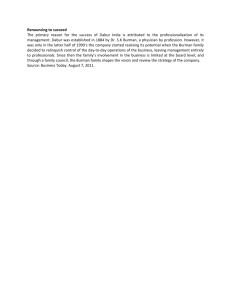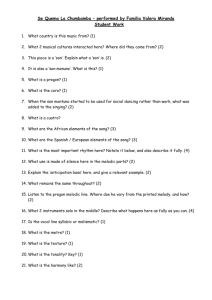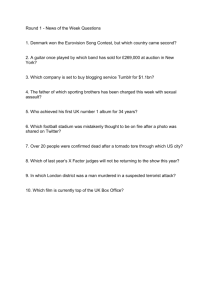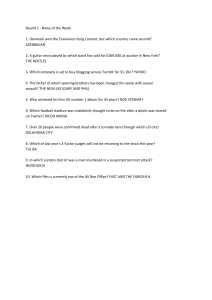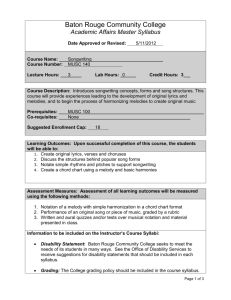Document 10466126
advertisement
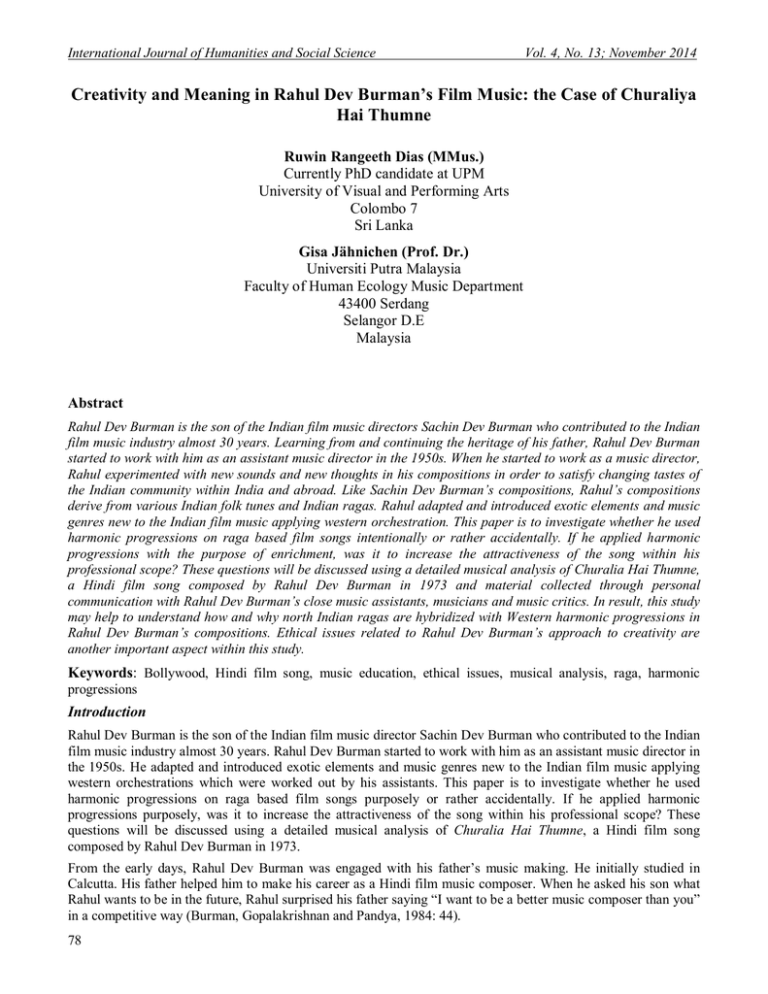
International Journal of Humanities and Social Science Vol. 4, No. 13; November 2014 Creativity and Meaning in Rahul Dev Burman’s Film Music: the Case of Churaliya Hai Thumne Ruwin Rangeeth Dias (MMus.) Currently PhD candidate at UPM University of Visual and Performing Arts Colombo 7 Sri Lanka Gisa Jähnichen (Prof. Dr.) Universiti Putra Malaysia Faculty of Human Ecology Music Department 43400 Serdang Selangor D.E Malaysia Abstract Rahul Dev Burman is the son of the Indian film music directors Sachin Dev Burman who contributed to the Indian film music industry almost 30 years. Learning from and continuing the heritage of his father, Rahul Dev Burman started to work with him as an assistant music director in the 1950s. When he started to work as a music director, Rahul experimented with new sounds and new thoughts in his compositions in order to satisfy changing tastes of the Indian community within India and abroad. Like Sachin Dev Burman’s compositions, Rahul’s compositions derive from various Indian folk tunes and Indian ragas. Rahul adapted and introduced exotic elements and music genres new to the Indian film music applying western orchestration. This paper is to investigate whether he used harmonic progressions on raga based film songs intentionally or rather accidentally. If he applied harmonic progressions with the purpose of enrichment, was it to increase the attractiveness of the song within his professional scope? These questions will be discussed using a detailed musical analysis of Churalia Hai Thumne, a Hindi film song composed by Rahul Dev Burman in 1973 and material collected through personal communication with Rahul Dev Burman’s close music assistants, musicians and music critics. In result, this study may help to understand how and why north Indian ragas are hybridized with Western harmonic progressions in Rahul Dev Burman’s compositions. Ethical issues related to Rahul Dev Burman’s approach to creativity are another important aspect within this study. Keywords: Bollywood, Hindi film song, music education, ethical issues, musical analysis, raga, harmonic progressions Introduction Rahul Dev Burman is the son of the Indian film music director Sachin Dev Burman who contributed to the Indian film music industry almost 30 years. Rahul Dev Burman started to work with him as an assistant music director in the 1950s. He adapted and introduced exotic elements and music genres new to the Indian film music applying western orchestrations which were worked out by his assistants. This paper is to investigate whether he used harmonic progressions on raga based film songs purposely or rather accidentally. If he applied harmonic progressions purposely, was it to increase the attractiveness of the song within his professional scope? These questions will be discussed using a detailed musical analysis of Churalia Hai Thumne, a Hindi film song composed by Rahul Dev Burman in 1973. From the early days, Rahul Dev Burman was engaged with his father’s music making. He initially studied in Calcutta. His father helped him to make his career as a Hindi film music composer. When he asked his son what Rahul wants to be in the future, Rahul surprised his father saying “I want to be a better music composer than you” in a competitive way (Burman, Gopalakrishnan and Pandya, 1984: 44). 78 © Center for Promoting Ideas, USA www.ijhssnet.com Sachin Dev Burman planned in which areas his son Rahul should be trained in order to become important to the film music industry as a future music composer. First, Sachin Dev Burman sent Rahul Dev Burman to the Brajen Biswas, a skillful tabla player, to learn the basics of rhythm and meter. After that, Rahul was sent to Ali Akbar Khan and later Ashish Khan to learn Sarod1. Rahul Dev Burman also mastered mouth harmonica at an early age (De Souza, 2012). He remembers that in 1950–51 his father Sachin Dev Burman explained the necessity of learning different kinds of instruments before dealing with music compositions: “Before you compose you must know the range of the instruments at your command to get the best out of them” (Sachin Dev Burman as cited in Burman, Gopalakrishnan and Pandya, 1984: 44). In a time when music composers relied mostly on traditional folk and classical music, Rahul Dev Burman started to experiment with new sound that was contemporary and catchy, influenced by imported music and experimenting with new instruments (Booth, 2010: 22; Bhosle, 1989, ARCPA1574: 00:00:37–00:01:04). Asha Bhosle says that Burman always used to think of new and innovated ideas, new voices and new styles. He could also have made classical compositions but he didn’t do that, instead he kept searching for new music (Bhosle, 1989, ARCPA1574: 00:01:30–00:01:55). Burman has innovative methods of recording new sounds. In the film song Churaliya Hai Thumne he used the sound of spoon tapping on a glass. Sometimes, he brought desks from a class room into the recording studio and used them as percussion instruments and sometimes he used bottles filled to different levels to create a hollow sound by blowing in to them (Raswar, 2012, ARCPA1574: 00:01:57– 00:02:55). Booth describes how Burman used new sound material for compositions that are applied for action scenes (Booth, 2012: 149). This should be further investigated since it leads to the insight that a changing attitude in film making such as strong cuts between staged scenes and action in order to pack the movies with opportunities for music and dance scenes was one of the driving forces in demanding a higher creative input. Analysis To show the details of the modernization process in an example, here is chosen the song Churaliya Hai Thumne composed by Rahul Dev Burman for the Hindi film Yaadon Ki Bharat. An analysis that is strictly focused on primary musical elements can help to evaluate the conditions and outcomes of this new type of compositions found in Rahul Dev Burman’s works. First, the song had to be transcribed since a full score does not exist. Some patterns are identified and summarized to visualize the harmonic progressions applied in the song. Then, each of the melody lines that represent the identified harmonic progression patterns is analyzed to get a clear idea about the melodic line. Each identified melodic pattern has to be analyzed in search for similar and different harmonic patterns in the sung melody and bass melody. Afterwards, the raga visible in the each pattern is extracted and put into its context. Figure 1: Different harmonic patterns in the song ‘Churaliya Hai Thumne’. 1 Sarod is an Indian string music instrument. 79 International Journal of Humanities and Social Science Vol. 4, No. 13; November 2014 It is clearly visible that harmonic pattern I is appearing more frequently than other harmonic patterns. Looking into the melodic patterns of harmonic pattern I, pattern I is almost the same in all six times except the bass movement. However, in harmonic pattern I the bass guitar movement is similar in some subsequent places as marked in the figure. In the second half of the bars 17, 24, 48, and 78, the bass guitar moves descending from the second inversion of A-minor to the main position of G-major using the chromatic beginning. Other harmonic patterns are analyzed accordingly to identify similarities and differences in the bass movement that shape an important fundament for harmonic progressions and a continuous groove. Figure 2: Similar sections in harmonic pattern I. notation and scheme by Ruwin Rangeeth Dias / Gisa Jähnichen. Figure 3: Overview of different chord progression patterns III2, III2*and III3 that are applied on the same melody. 80 © Center for Promoting Ideas, USA www.ijhssnet.com Figure 4: Different chord progressions for similar melodic lines. Notation by Ruwin Rangeeth Dias. Some different chord progression patterns appear in the song and are always related to the same melodic sequence as it is shown in figure 4. As north Indian musicians always consider the main reference tone as ‘Sa’, the raga analysis will be comforted with transposing the melodic lines in a way that ‘C’ is the main reference tone to ease reading and comparison. Before analyzing each melodic pattern, raga Mishra Pilu and raga Kafi, which are seemingly the raga foundation of this song, will be briefly introduced. The figure 5 shows the approximate ascending and descending structure of raga Mishra Pilu. In north Indian classical music, raga Pilu is typified as a ‘light classical raga’. Figure 5: Ascending and descending tones of raga Mishra Pilu. Notation by Ruwin Rangeeth Dias. Figure 6: Main phrase of raga Mishra Pilu. Notation by Ruwin Rangeeth Dias / Gisa Jähnichen. The figures show the approximate ascending and descending structure of raga Kafi. The abstract scale shows intervals alternating between a whole and a half step. The exact pitch frequencies determining the intervals, however, can differ from diatonic understanding. Here, they are depicted only roughly for orientation. Figure 7: Approximate ascending and descending structure of raga Kafi. Notation by Ruwin Rangeeth Dias / Gisa Jähnichen. 81 International Journal of Humanities and Social Science Vol. 4, No. 13; November 2014 Figure 8: Main phrases of raga Kafi. Notation by Ruwin Rangeeth Dias. Nine occurrences can be identified that represent harmonic pattern I and are melodically the same. Therefore, the analysis of bar 13–16 will be applied to all the other similar melodic patterns as well. The features of raga Mishra Pilu can be traced in the melodic line from the 13th bar to the beginning of the14th bar. We can also consider this melodic line as a phrase taken from raga Kafi, because the melodic line from the 13th bar to the beginning of the 14th bar combines features of raga Mishra Pilu and Kafi. Figure 9: Melodic sequences with harmonic pattern I. Notation by Ruwin Rangeeth Dias. Figure 10: Ragas in melodic sequences I. Notation by Ruwin Rangeeth Dias. From the next figure, three occurrences can be identified that represent harmonic pattern I2 and are melodically the same. Therefore, the analysis is applied to all the other similar melodic patterns as well. The features of raga Kafi can be traced in the melodic line from the 28th bar to the beginning of the 31st bar. We can relate these melodic phrases with the raga Kafi, however, the real mood of raga Kafi cannot be traced in the melody. 82 © Center for Promoting Ideas, USA www.ijhssnet.com Figure 11: Melodic sequences in harmonic pattern I2. Notation by Ruwin Rangeeth Dias. Figure 12: Ragas in melodic sequences I2. Notation by Ruwin Rangeeth Dias. Different patterns are identified according to chord progressions. Some different patterns represent the same melody as we can see in the figure. In figure 3, three occurrences can be identified that represent varieties of harmonic pattern III and are melodically the same. Therefore, the analysis is applied to all the other similar melodic patterns. Figure 13: Ragas in melodic sequences III. Notation by Ruwin Rangeeth Dias. Discussion: Ethical Issues and Modernity Rahul Dev Burman had very talented musicians, assistants and music arrangers in his team. Manohari Singh is one of the most senior members of Rahul Dev Burman’s music crew. In credits of movies composed by Rahul Dev Burman, he did not forget to put the names of Manohari Singh, Vasudeo Chakravarty and Maruti Rao Keer, as his assistants who obviously did good work. Despite his three most important assistant composers, Rahul Dev Burman had up to eight sitting musicians who contributed remarkably to the outcome of music ideas realized in Hindi films (Booth, 2009:75). Kersi Lord, Bhupinder Singh, Uttam Singh, Babloo Chakraborty, Laxmikant Shantaram Kudalkar, Pyarelal Ramprasad Sharma, Franco Vaz, Raj Sodha, Kishore Sodha were among them for a time (Ganesh, 2012; Mullan & Dias, 2014). Sitting musicians can also be seen as the lowest category in the composition business and as such they must have been of really great importance since those people had to do the practical work. Rahul Dev Burman’s personal musicianship was rather limited and, therefore, most acknowledged, i.e. his playing of the harmonica in some cases (Raswar, 2012). However, this does not mean that his creative input was of lower impact. He spent more than four years with his gurus as a family member and learnt basics of north Indian classical music. Likewise his father, Rahul Dev Burman also composed a number of songs based on classical ragas. Premchand mentions that the song Churaliya Hai Thumne which is composed by Rahul Dev Burman is based on the raga Pilu (Premchand, 2003: 451). 83 International Journal of Humanities and Social Science Vol. 4, No. 13; November 2014 In the 1970s, some of Rahul Dev Burman’s sound tracks were said to be composed in collaboration with film director Nasir Hussain, especially the song Churaliya Hai Thumne from the Hindi film ‘Yaadon Ki Baraat’ (Raswar, 2012, ARCPA1574: 00:21.19–00:21:46). This particular song’s first stanza is exactly matching the song “If It’s Tuesday’’. Borrowing the melody might be the idea of film director. If not what means this “collaboration” else than taking another composer’s idea? Nasir Hussain seems to have done borrowings from other composers or musicians earlier as Booth (2012: 153) reports on his title song for Dil Deke Dekho (1959) where he tried to introduce kind of western youth music by using American folk accompanied by a bongo-congo pair. Further should be considered that already Rahul Dev Burman’s father himself took a song of his son into his own film music (Burman, Gopalakrishnan and Pandya, 1984) giving a long lasting example of ethical approaches in the film music industry. ‘Borrowing’ his song idea must have been to him an honor and in his later professional life he also ‘honored’ a number of good song ideas seemingly without being fully aware of an ethical issue. Only when his many successful songs were academically scrutinized, the public mind split up into pro and contra. Analyzing the basic structure, melodic shapes of the first stanza and the tempo it becomes clear that Churaliya Hai Thumne is an adaptation of the song If It's Tuesday sung by Bojoura composed by Walter Scharf for the Film ‘If It's Tuesday It Must Be Belgium’ in the year 1969. The film ‘Yaadon Ki Baraat’ was four years after the film ‘If It's Tuesday It Must Be Belgium’ released. Figure 14: Basic comparison of composition features in the two songs. Ranade was also raising the plagiarism issue related to Burman’s compositions that are mentioned by Karthik (2007) and some bloggers who relate their questions to this source. “An important objection to Rahul’s music is his skillful but to some extent unconcealed musical plagiarism - most of the times the source being ‘Western music’” (Ranade, 2006: 302). Karthik listed 44 cases, but he is most of the time defending Burman’s approach as being in the trend of his time and trivializes these cases. Others see in the taking of others’ song ideas a special case of ‘Indianization’ (Booth & Shope, 2014: 30; Ranade, 2006: 214). I could look through those songs and find out some of the songs are not influenced at all while some of the “borrowed” songs are indeed richly inspired or copied. Later, Burman also admitted that he adopted foreign songs while he is composing songs. The most important thing here is to find out why he actually did so. Figure 15: Information on some R.D. Burman songs well known to audiences in India and abroad that are taken from songs of other composers. In an interview with Gopalakrishnan and Pandya Rahul, Burman says "In the past two years I haven't copied any.’Betaab', 'Masoom' have both been totally Indian." …"If I like a particular line I take it but after that I improvise. I only borrowed eight bars from Abba's Mama Mia. […] If you copy in toto you may have trouble. 84 © Center for Promoting Ideas, USA www.ijhssnet.com Again, there are common phrases in music, too, and two people using the same may just be a coincidence“(Burman, Gopalakrishnan and Pandya, 1984: 47). One of the problems shining up here is the perception of creatively borrowing can only be done with music of the West, while borrowing from Indian sources might be less harmful and actually acceptable since the composers feel as this is owned by any Indian and therefore “totally Indian” (Booth, 2010: 6). Conclusion According to Sharma, Hindi film music composers usually outline the main melody and all the other arrangements including orchestration, writing the notations, distributing parts among musicians, conducting in the recording are the responsibility of music assistants or music arrangers (Rane & Sharma, 2012: 00:35:14– 00:36:02). If music composers are ‘borrowing’ a few melodic lines from other composers, the music composer contributes even less to the original work. This is a matter of authenticity and beyond the scope of this paper. However, though we can analyze and see elements of a few ragas; it can be clearly assumed that the composer did not look into any raga while composing this song. He might have been only inspired by the song ‘If it’s Tuesday’. Shadows of ragas can be found in any Hindi film song based on the way of how the singer is influenced by his or her music education and own music culture. Also, harmonic progressions seem to be used rather accidently. In general, if the film song is really composed based on a particular raga, Indian film musician know best how to negotiate between harmonic theories and the basic principles of ragas in keeping the mood. So, the final open questions remain whether this Hindi film song is read as a copied harmonized melody or a raga based and transformed song in which attractive elements from a foreign song are adopted and developed using eccentric tools such as a spoon or a tennis table. What makes this song being indeed successful? Why is the process of its making not less authentic to Hindi film songs than the mixture of tradition and Western harmonic progressions? What is the meaning of being creative? Modern CD productions share many similarities with the type of music production described here. However, what did this mean in the 1970s to a growing film industry? These and other questions have to be answered in a more comprehensive way. To conclude this short study with some provocative thoughts: The most deciding quality of Rahul Dev Burman’s compositions was that they actually met the taste of the time and that they were building up trends that were followed by others (Morcom, 2007: 28). Seen in a retrospective way, meeting the taste of the time was largely depending on how far one went in applying inspirations of the West from which the desired modernity and the power connected to it derived. Rahul Dev Burman, himself an eccentric, might have been the brave man who dared to copy styles or whole song ideas, to mix exotic sounds and to ignore their historical or cultural meanings of traditions that appeared to burden his creative mind. 85 International Journal of Humanities and Social Science Vol. 4, No. 13; November 2014 References Bhosle, Asha, Rahul Dev Burman and Girija Rajendran (1989). R.D–Asha Interface. Screen Magazine, Issue 14 (April), p. 12. Booth, Gregory D. (2009). Der ‘Fremde’ Einfluss in R. D. Burmans Diskurs und musikalischer Praxis [The “Foreign” Influence in Discourse and Practice in the Music of R. D. Burman]. Fokus Bollywood: Das indische Kino in wissenschatlichen Diskursen. Edited by C. Tieber. Vienna: Lit Verlag, pp. 67-83. Booth, Gregory D. (2010). “Burman–dada was Total Indian” – Issues of Style, Genre and Indigeneity in S. D. Burman’s Film Songs. Journal of the Indian Musicological Society 40 (2009-2010), pp. 6-28. Booth, Gregory D. (2012).R.D. Burman and Rhythm: “Making the Youth of This Nation to Dance”. BioScope, 3(2), 147–164. Booth, Gregory D. and Bradley Shope, eds. (2014). More Than Bollywood: Studies in Indian Popular Music. Oxford: Oxford University Press. Burman, Rahul Dev, V. S. Gopalakrishnan and Meera Pandya (1984). Rahul Dev Burman in New York. Filmfare Magazine, Issue June 16–30, Mumbai: The Times Group. De Souza, Michelle (2012). R. D. Burman Music Biography. Documentary. Accessible through ARCPA2 1574. Ganesh, Deepa (2012). Behind the Song. The Hindu, 25 May. Accessible via: http://www.thehindu.com/todayspaper/tp-features/tp-fridayreview/behind-the-song/article3453727.ece. Last retrieved 22 November, 2014. Karthik, S. (2007) Chronicles of Plagarism in Indian Film Music. Accessible via http://www.itwofs.com/. Morcom, Anna (2007). Hindi Film Songs and the Cinema. Aldershot: Ashgate. Mullan, Homi and Ruwin Rangeeth Dias (2014). Personal communication, 18 November: Mumbai. Premchand, Manek (2003). Yesterday’s Melodies Today’s Memories. Mumbai: Jharna Books. Premchand, Manek and Ruwin Rangeeth Dias (2014). Personal communication, 8 January: Mumbai. Ranade, Ashok Damodar (2006). Hindi Film Song: Music beyond Boundaries. New Delhi: Promilla and Company Publishers. Rane, Ashok (2011). Interview with Pyarelal Sharma. Anthony Gonsalves, the Music Legend. Documentary. Produced by Shreekant Joshi and Mrinalini Joshi. Mumbai: Passi Flora Films. Raswar, Ranjana (2012). IBN: Maestros: the sound of R. D. Burman. Documentary. Accessible as <http://ibnlive.in.com/videos/219001/music-maestro-the-sound-of-rd-burman.html> and through ARCPA1572. 2 Audiovisual Research Collections of Performing Arts [ARCPA] at the Music Department, Faculty of Human Ecology, Universiti Putra Malaysia (publicly accessible). 86
